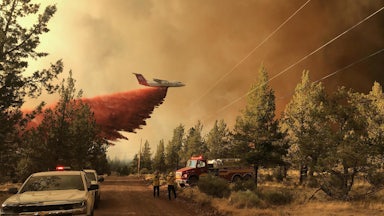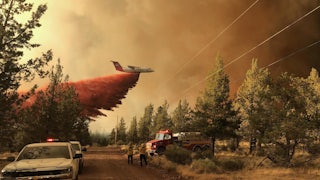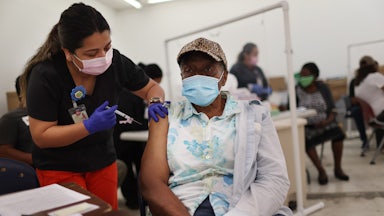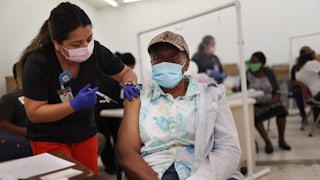Could climate change, of all things, finally force Americans to rethink suicide prevention? Of the top 10 causes of death in the United States, suicide remains stigmatized among the masses and, even among scholars, poorly understood. The U.S. has largely failed to stem the rising tide: Between 1999 and 2019, suicide rates increased by about 33 percent overall, according to the Centers for Disease Control. Among youth ages 10 to 24, that figure is almost twice as high. At the end of another year defined by deaths of despair, what has commonly been considered an individual act—and, accordingly, met with solutions of a similar scope—has become an ever-more-obvious public health issue in desperate need of a new approach.
Together, decades of statistical analysis of suicides in the aggregate and “psychological autopsies” of the individual dead suggest that suicide is linked to dozens of risk factors, including genetic predisposition; mental illness (but not always); personal, social, or financial problems; and trauma. There’s a longstanding debate about whether environmental changes should be added to the list, too. Since at least the nineteenth century, social scientists have observed that suicides seem more common as spring gives way to summer—and, just as often, dismissed them as spurious. In recent years, however, researchers have begun to reevaluate the role played by heat, air quality, and the existential despair of climate change, too. Turns out, they’re linked in ways few ever imagined.
The latest wave of research on the climate-suicide link started more or less with a 2018 paper co-authored by economist Marshall Burke, principal investigator at Stanford’s Environmental Change and Human Outcomes Lab. Researchers evaluated the impact of local ambient temperature on the rates of suicide in the recent past and projected it forward into a climate-changed future. When controlling for numerous factors, including regional poverty, gun ownership rates, and abrupt shocks like celebrity suicides, data suggest that unmitigated global warming could contribute to as many as 40,000 excess suicides by 2050 in the U.S. and Mexico alone. Crucially, this relationship between heat and suicide appears to be “stable across time, baseline climate, air conditioning penetration rates, accessibility of mental health services, and other factors,” according to Jamie T. Mullins and Corey White, who reported similar results in 2019, calling into question whether adaptation will be possible.
Despite centuries of theorizing, much about the mechanism connecting suicide with heat and humidity (which may be an even more direct risk factor) remains unknown. Researchers are exploring several possible biological explanations, including disrupted sleep and neurotransmitters, which play a role in both thermoregulation and emotions, says psychiatrist Elizabeth Haase. But downstream social and economic consequences are likely also at play. In India and Australia, for example, rising temperatures have already contributed to drought and resulting crop failure, which appears to have made many farmers and others in intimate relationships with the landscape increasingly vulnerable to suicide.
Other environmental factors are also receiving new scrutiny. A growing body of evidence has shown that poor air quality—driven by emissions from fossil fuels, ozone production, and fires—is associated with an increased risk of suicide on the order of 1 to 2 percent per day of exposure, says Caroline Dumont, an assistant professor of clinical psychiatry at Yale School of Medicine and the co-author of a recent paper on climate change and the risk of completed suicide. At this point, the existing studies on the topic have primarily been attempts to establish a correlation between suicide and air pollution, so other factors may be at play. But Dumont thinks there could be a causal relationship between the two: Upon entering the body, microscopic soot can not only trigger inflammation in the lungs (asthma) and heart (cardiovascular disease), but also in the brain—with the potential for similarly sickening consequences.
Even less is understood about the psychological impact of the existential threat presented by climate change. It’s clear that accepting that the Earth is imperiled—and that, at least in the U.S., our lifestyles play a significant role—is difficult. Doing something about it is even harder. Furthermore, while rising atmospheric carbon from any source would be terrifying on its own, anthropogenic climate change—and the implied personal culpability—can stir up a potent cocktail of anxiety, anger, shame, and ennui. At times, the resulting conversation can feel eerily reminiscent of the early centuries of Christianity, when believers felt that “the longer one’s life, the more opportunity there was to sin and the less chance of eternal bliss,” writes journalist George Howe Colt in November of the Soul: The Enigma of Suicide, his 600-odd-page cross-cultural history of suicide and euthanasia. “Suicide—in the form of martyrdom—became the quickest way to heaven.”
This is a pretty awful notion to consider—suicide as the last best hope for virtue. When put in these terms, no respectable person would endorse it today. Yet the troubling climate equivalent of this line of thinking—the shorter your life, the fewer emissions you produce—is implicit in everything from the early pandemic-era “we are the virus” refrain to the “soft Malthusianism” periodically pushed by major news outlets. When consumers are told they are equally to blame for the climate crisis (a narrative conveniently crafted by the fossil fuel industry) but face a dearth of options for actually leading a more climate-friendly life, it’s all too easy to convince people to feel guilty merely for living. The market says there’s a fix for that, too: At least one carbon offset company is now encouraging customers to pay penance not only for their holiday travel, but for their very breathing (which, by the way, is already carbon neutral).
But the scientific evidence linking climate change’s existential perils to mental illness and suicide is effectively non existent, even as eco-anxiety has become something of a household term. Once again the problem is structural: American psychologists and psychiatrists do not routinely ask clients whether they feel their mental health issues are spurred on by climate change. Furthermore, the accounts of people who die by suicide are reflexively distrusted, even if they explicitly name environmental issues as a source of their distress. On a sunny Saturday morning in April 2018, David Buckel, a 60-year-old LGBTQ rights lawyer and community composter, set himself on fire in Brooklyn’s Prospect Park. “My early death by fossil fuel reflects what we are doing to ourselves,” he wrote in his suicide note, which he had emailed to loved ones and journalists just minutes earlier. Buckel’s death put his family and other would-be supporters in a bind: They “didn’t want to ignore the deep personal desperation they believe influenced his decision,” J. Oliver Conroy wrote in The Guardian a year later, “but they also didn’t want to detract from his dedication to causes that meant a lot to him.” What was explicitly intended as a call to political action became a mere personal tragedy.
Of course, “climate can be a toxic dump for everything that bothers you,” says psychiatrist Lise Van Susteren, co-founder of the Climate Psychiatry and Climate Psychology Alliance. Even so, Van Susteren believes that mental health issues and, yes, suicide are connected to climate change. “It’s always a complex situation,” she says, “but here’s the thing, [on] my dashboard, the lights are all blinking red on this.” Youth seem especially psychologically vulnerable to these accelerating shifts—in particular the inaction of older generations that underlies them. In a recent survey of 10,000 people ages 16 to 25, 56 percent agreed with the statement that humanity is doomed, and many reported believing that they have no future. Even so, they feel a responsibility to act: 37 percent of young Americans say climate change is their top personal concern, according to the Pew Research Center.
When it comes to a topic as sensitive as suicide, holding faulty narratives up to the light is tricky. Public figures, including many journalists, are often reluctant to discuss individual suicides, which can spark contagion and create copycats. By connecting suicide to root causes like climate change, for example, “there’s the danger that it serves as a rationale,” Van Susteren says (it shouldn’t). At the same time, suicide in the aggregate has been co-opted by politicians and diplomats around the world, many of whom use suicide as an analogy for climate inaction: It’s a “suicidal war with nature,” argues the Secretary General of the United Nations António Guterres; a “global suicide pact,” per U.S. Special Presidential Envoy for Climate John Kerry; and “a formula for collective suicide,” according to the author Amitav Ghosh in The Great Derangement.
In truth, climate change may be much better understood as mass murder—coincidentally, another form of violence linked to the weather. In the new movie, Don’t Look Up, writer-director Adam McKay creates a climate change parable out of a fictional asteroid hurtling toward Earth. Spoiler: Denial, inaction, and greed prevail, and the film ends with everyone dying, except for the politicians and tech CEOs who impeded action in the first place. These privileged few hitch a ride aboard a spaceship, safely ensconced in cryogenic chambers for the 22,000-year trip to the nearest Earth-like planet. While it may seem farcical, it’s that vision—of damnation for most, and life for the most undeserving few—that feels closer to the world we live in than a “suicidal war with nature.” Even in the United States, the land of red meat and conspiracy theories, the majority of people believe their government should do more to act on climate, yet fossil fuel executives and their political allies continue to make sure it won’t. So where, exactly, does the responsibility lay?
Unfortunately, American society contains numerous examples of this sort of structural malevolence, wherein individuals are asked to shoulder the burden of problems caused by interlocking, and largely invisible, corporate interests. While it’s worth reiterating that the circumstances of every suicide are unique to the individual, our context is shared, and that context is often unbelievably bleak. To take just two instructive numbers, consider that 28 million Americans currently lack health care, while 132 million have a firearm in their home. In the U.S., the logic of suicide prevention often says, limit opportunities among those who already want to die (locking up firearms) first, and consider making life more liveable (affordable, comprehensible health care for all) second. As a result, even interventions that appear structural, like the act that will make 9-8-8 the nationwide mental health crisis and suicide prevention number by July 2022, often fall short of the radical vision required to save lives.
That may be changing. Right now, evidence is mounting that the supposedly paradoxical decline in suicides in 2020—a year of unprecedented stress and isolation due to the Covid-19 pandemic—was due in part to many Americans receiving an influx of cash in the form of government assistance. In the case of climate change, scientists will always call for more data, but the link between a warming world and rising suicide rates is already clear enough to demand action. In addition to providing care in a crisis, psychotherapists and psychiatrists should be leading the way to a carbon-zero future. “If we don’t take the lead on answering these questions, then we will suffer the consequences,” Van Susteren says. People don’t just need Better Help; they need a better world.
The National Suicide Prevention Lifeline is a hotline for individuals in crisis or for those looking to help someone else. To speak with a certified listener, call 1-800-273-8255.










